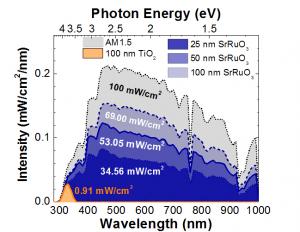New material approach should increase solar cell efficiency
"When designing next generation solar energy conversion systems, we must first develop ways to more efficiently utilize the solar spectrum," explained Lane Martin, whose research group has done just that.
Martin's research group brought together aspects of condensed matter physics, semiconductor device engineering, and photochemistry to develop a new form of high-performance solar photocatalyst based on the combination of the TiO2 (titanium dioxide) and other "metallic" oxides that greatly enhance the visible light absorption and promote more efficient utilization of the solar spectrum for energy applications.

The correlated electron metal SrRuO3 exhibits strong visible slight absorption. Overlaid here on the AM1.5G solar spectrum, it can be seen that SrRuO3 absorbs more than 75 times more light than TiO2. The structural, chemical, and electronic compatibility of TiO2 and SrRuO3 further enables the fabrication of heterojunctions with exciting photovoltaic and photocatalytic response driven by hot-carrier injection.
According to Martin, the primary feature limiting the performance of oxide-based photovoltaic and/or photocatalytic systems has traditionally been the poor absorption of visible light in these often wide band gap materials. One candidate oxide material for such applications is anatase TiO2, which is arguably the most widely-studied photocatalyst due to its chemical stability, non-toxicity, low-cost, and excellent band alignment to several oxidation-reduction reactions. As the backbone of dye-sensitized solar cells, however, the presence of a light-absorbing dye accounts for a large band gap which limits efficient usage of all but the UV portion of sunlight.
"We observed that the unusual electronic structure of SrRuO3 is also responsible for unexpected optical properties including high absorption across the visible spectrum and low reflection compared to traditional metals," stated Sungki Lee, the paper's first author. "By coupling this material to TiO2 we demonstrate enhanced visible light absorption and large photocatalytic activities."
"SrRuO3 is a correlated electron oxide which is known to possess metallic-like temperature dependence of its resistivity and itinerant ferromagnetism and for its widespread utility as a conducting electrode in oxide heterostructures," Lee added. Referring to this material as a "metal," however, is likely inappropriate as the electronic structure and properties are derived from a combination of complex electronic density of states, electron correlations, and more.
Using a process called photo-excited hot-carrier injection from the SrRuO3 to the TiO2, the researchers created new heterostructures whose novel optical properties and the resulting high photoelectrochemical performance provide an interesting new approach that could advance the field of photocatalysis and further broaden the potential applications of other metallic oxides.
This work provides an exciting new approach to the challenge of designing visible-light photosensitive materials and has resulted in a provisional patent application.
"The I2CNER project brings together some of the leading energy researchers from around the globe," explained I2CNER Director Petros Sofronis, who is also a professor in the Department of Mechanical Science and Engineering at Illinois. "Results from Dr. Martin's research group and others demonstrate that I2CNER is not only an experiment on international collaboration. It is a concerted institutionalized effort to pursue green innovation and reduced CO2 emissions, as well as to advance fundamental science and develop science-based technological solutions for the reorganization of sustainable and environmentally friendly society."
Source: Nanotechnology Now
- 267 reads




